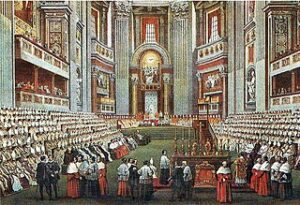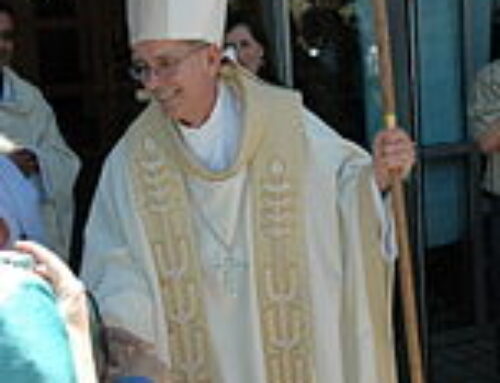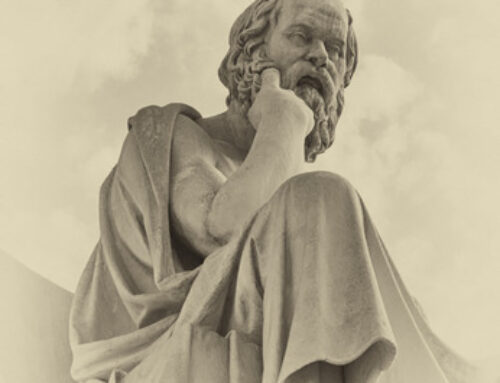 Part 1 of this essay explained the continuing controversy over whether the Catholic church should allow women to serve as deacons. Part 2 will consider how the centuries-old negative image of women has affected that controversy.
Part 1 of this essay explained the continuing controversy over whether the Catholic church should allow women to serve as deacons. Part 2 will consider how the centuries-old negative image of women has affected that controversy.
As Semitic History scholar Caroline M. Breyfogle notes, at one time, “in harmony with the animistic conception of woman, a goddess became an object of worship in Israel, and women served at the sanctuary.” (Exod. 38:8, 1 Sam. 2:22) . . . But Judaism changed that, as Neh 7, Ezra 2, and Lev. 6 and 7 show. The attitude toward women turned negative and restrictions were imposed, resulting in their “moral and intellectual depreciation.” They were considered “naturally more vicious, more dedicated to envy, discontent, evil speaking, and wantonness” than their male counterparts. “By means of his mastery over women within the domestic, the social, and the economic environments, man made the church also his own domain. The whole Jewish world then belonged to man, [and] woman was expelled therefrom, without rights, duties, or possibility of achievement.”
The status of women remained the same during Jesus’ lifetime and after His resurrection, and it has influenced Catholic religious belief ever since. (This is not to suggest Jesus approved that status.) In Breyfogle’s words, “perhaps in no sphere of life has the subordination of woman so perpetuated itself as in matters ecclesiastic . . . [Woman’s] position in the conservative traditions of the church has been one of intellectual and religious subordination.”
St. Thomas Aquinas’s view of women certainly contributed to the lowered status of women after the time of Christ, much as Aristotle’s view had centuries before Christ. (It should be noted that neither man did so maliciously.)
Aristotle described women as “incomplete” and for that reason “perhaps inferior beings.” He believed they are “more compassionate and more readily made to weep, more jealous and querulous, fonder of railing, and more contentious” than men. In addition, they are “more subject to depression of spirits and despair . . . as well as more shameless and false, more readily deceived, and more mindful of injury, more watchful, more idle, and on the whole less[sic] excitable” than men. [“More” excitable may have been meant). Moreover, “the male is more ready to help, and, as it has been said, braver than the female . . .”
Aquinas, according to Marie I. George, “in several passages . . . asserts that the inferiority of women lies not just in bodily strength but in force of intellect.” She suggests he drew this view from First Corinthians, “Man was not created for the sake of woman, but woman was created for the sake of man” and Genesis, “It is not good that the man should be alone. I will give him a helpmate.” George believes Aquinas reasoned from these scriptural passages that “existing for the sake of Adam made Eve inferior to him.” She adds that “from Corinthians ‘Man is the head of woman,’ and Ephesians ‘A husband is the head of his wife,’ Aquinas [took] it as evident that if men are meant to rule, it can only be by virtue of [their] intellectual superiority. . .”
As I noted in Part 1, John Paul II gave three reasons for the Church’s view that women should never be deacons, let alone priests. Those reasons were a) Christ chose only men, b) the Church has followed Christ’s example, and c) the Church has consistently taught that excluding women from the deaconate and priesthood is God’s plan. The first of these, Christ’s choosing men, is most important because the other two depend on it. As I also pointed out, it is based on the assumption that there could be no other conceivable reason for Jesus choosing men than the unsuitability of women for those roles. I then suggested that assumption is hasty because there are at least two other possible reasons. Now I will add another cause for questioning the validity of that assumption: the Gospel record of Jesus’s treatment of women.
James A. Borland succinctly sums up Jesus’ interactions with women: “Jesus demonstrated only the highest regard for women, in both his life and teaching. He recognized the intrinsic equality of men and women, and continually showed the worth and dignity of women as persons. Jesus valued their fellowship, prayers, service, financial support, testimony and witness. He honored women, taught women, and ministered to women in thoughtful ways.” (See here for Borland’s supporting citations from John 4 and 8; Luke 7, 8, 11, 13, 23, 44; Matthew 9; and Mark 5.)
Jesus’ perspective, Borland shows, was very different from the prevailing depreciation of women in His age. I believe this difference lends credence to the idea that Jesus did not mean His choice of men to be the model for all time.
Another argument against women deacons (and priests) might be made, in addition to the three Pope John Paul enumerated. It is the historical fact that relatively few women have attained anything close to what men have achieved over the last two millennia. The following syllogism might be constructed from Sacred Scripture to support this argument: “Jesus said ‘By their fruits you shall know them’; women have produced little or no intellectual fruit; therefore, women are intellectually inferior.”
Interestingly, very similar reasoning has been applied to many groups of men! For example, in the United States during the 19th and 20th centuries, the Germans, the Irish, the Italians, and the Hispanics were (in that order) not only considered inferior, but for that reason denied opportunities to advance beyond the most menial jobs. African Americans were treated much worse, and not only during the time of slavery but for a shamefully long time afterward. And in all those cases, the failure to achieve what the people were forbidden to attempt was ironically taken as proof of their inferiority.
That so-called logic is recognized as fallacious in the cases of all those male groups. We now know that the reason they didn’t achieve was not a lack of capacity, but the denial of opportunities to demonstrate their capacity. When the opportunities were permitted, the impediment was removed, and achievement became possible.
Women suffered the same stereotypes and injustices for an even longer time, but eventually they broke through the closed doors and low “ceilings” established by men. Today women enjoy roles their grandmothers could only dream of. They are athletes, airline pilots, mathematicians, research scientists, college professors and presidents, surgeons, engineers, CEOs of companies, and high-ranking government officials.
Yet another argument that could be made against women deacons (and priests) is that “If God wanted women to be deacons or even priests, the Holy Spirit would surely have let the hierarchy know.” To which the retort is “What makes you think He hasn’t done that?” It is a mistake to believe that bishops, cardinals, and even popes are better at listening to God’s messages and acting on them than the rest of us are. Nor does the Holy Spirit force them (or us) to act on His messages, particularly when He chooses simple, un-anointed folks to deliver them.
But despite women’s overcoming most barriers, one area that remains closed to women, oddly enough, is the one in which their “credentials” are every bit as impressive as men’s. I’m speaking, of course, of the deaconate (and perhaps the priesthood). And what exactly are those “credentials”?
First, bearing God’s own image: Genesis 1:27 says “God created mankind in his own image, in the image of God he created them, male and female he created them.” And what does God’s image refer to? Surely not His omnipotence, omnipotence, or purely spiritual nature, but instead, powers of mind—notably reasoning, understanding, distinguishing good from evil, and choosing one’s actions. Women share these powers of mind with men.
Second, being men’s equals in dignity: Galatians 3:28 says, “There is neither Jew nor Greek, there is neither slave nor free, there is no male and female, for you are all one in Christ Jesus.”
Third, being deserving of love, respect, and fairness of treatment. Several Gospels say: “You shall love your neighbor as yourself.” But nowhere does Scripture define “neighbor” as men only. Accordingly, not only are women commanded to grant what men deserve, but men are commanded to reciprocate.
The conclusions reached here concerning the history of women’s exclusion from Holy Orders may not, by themselves, rise to the level of irrefutable proof, but they surely suggest the wisdom of re-examining the matter. I realize the hierarchy may be strongly tempted to reject re-examination on the ground that “what has been taught for centuries should not be changed.” But that idea is indefensible on at least two counts. Moral theology requires that wrongs be righted and errors corrected as soon as they are discovered. (See, for example, Matt 5:24 ” . . . first go and be reconciled with your brother [or in this case sisters]; and then offer your gift.”) Moreover, there is considerable evidence that some things that have been “taught for centuries” have been re-examined and changed, indeed reversed. For example, the teachings that usury is a sin, slavery isn’t, and the sun revolves around the earth.
I believe that the Holy Spirit speaks quietly to the anointed and to the un-anointed, but also that they can receive and embrace the message only if they are humble of heart and neither preoccupied with other matters nor committed to opposing ideas. I pray that the hierarchy can be both humble and free of the other obstacles in the issue about women, as well as other important issues.
Copyright © 2024 by Vincent Ryan Ruggiero. All rights reserved


